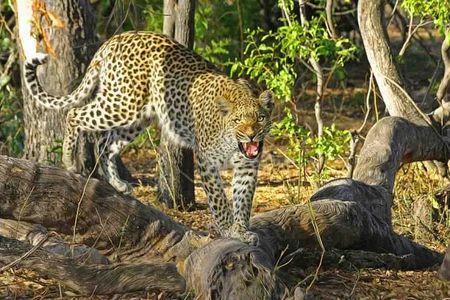Spots in the Shadows: A Wild Encounter at Amagarh Leopard Safari
 Palakshi Meharwal
24 Jul, 2025
8 mins read
24
Palakshi Meharwal
24 Jul, 2025
8 mins read
24

Tucked away in the serene outskirts of Jaipur, Amagarh Leopard Safari offers a rare glimpse into the wild heart of Rajasthan. Unlike conventional wildlife sanctuaries, this hidden gem takes visitors on an unfiltered journey through scrub forests and rocky outcrops, where leopards roam free in their natural habitat. “Spots in the Shadows†is more than a poetic title—it’s a vivid representation of the elusive, majestic creatures that call Amagarh their home.
The Untamed Beauty of Amagarh
Amagarh Forest is located near the historic Galta Ji Temple, surrounded by hills and dry deciduous forest. Unlike more commercialized reserves, this area remains relatively undisturbed, providing a more organic and authentic wildlife experience. The forest, once part of the hunting grounds of Jaipur’s royalty, is now a designated conservation area, making it both historically and ecologically significant.
Amagarh’s terrain, marked by steep ridges, ancient temples, and dense thickets, creates the ideal environment for leopards to thrive. These solitary predators often blend into the rocks, making sightings unpredictable and thrilling. What sets Amagarh apart is that it doesn’t feel curated—nature unfolds on its own terms.
A Safari Like No Other
The Amagarh Leopard Safari is not your typical wildlife park experience. Conducted in 4x4 gypsies and accompanied by trained forest guides, the safari winds through unpaved trails and narrow passes where leopards are often seen basking on boulders or moving stealthily through the shadows.
Mornings and late afternoons are the best times for sightings, as leopards tend to be more active during these cooler hours. While leopards are the star attraction, visitors might also spot hyenas, foxes, porcupines, nilgai (blue bulls), and an array of bird species like Indian eagle owls, peacocks, and partridges. The rich biodiversity reflects the balanced ecosystem supported by this relatively undisturbed habitat.
Why Amagarh is Gaining Popularity
Though lesser-known than the celebrated Jhalana Safari Park or Ranthambore National Park, Amagarh’s charm lies in its raw and unscripted encounters with wildlife. In recent years, wildlife photographers and conservationists have been drawn to Amagarh for its increasing leopard population and unique topography.
As per field observations and local forest data, there are over 15 leopards currently thriving in this forest patch. The Rajasthan Forest Department, recognizing the ecological and tourism potential of the area, has introduced eco-tourism initiatives that support both wildlife protection and local employment.
In an interview with a senior forest official published in The Times of India, it was noted that community involvement has been central to Amagarh’s conservation success. Locals are trained as naturalists, which not only creates awareness but also promotes sustainable tourism.
Practical Information for Visitors
Best Time to Visit:
The ideal months for a leopard safari in Amagarh are October to March, when the weather is cooler, and the forest is more accessible. During monsoon (July–September), safaris may be restricted due to terrain conditions.
Safari Timings:
- Morning Safari: 6:30 AM – 9:30 AM
- Evening Safari: 3:30 PM – 6:30 PM
- These timings are subject to change based on seasonal daylight hours and forest regulations.
What to Carry:
- Binoculars and cameras (preferably with zoom lenses)
- A light jacket (especially in winter)
- Reusable water bottles
- Avoid bright-colored clothing or strong perfumes
Conservation Beyond Tourism
While tourism is a major part of Amagarh’s identity, its conservation mission remains the priority. Educational programs for school children, wildlife awareness workshops, and anti-poaching patrols are regularly conducted in the region.
A recent report in Down to Earth highlighted the growing need for habitat corridors connecting fragmented forest patches around Jaipur to ensure long-term survival of leopard populations. Amagarh’s success could serve as a model for similar regions where wildlife and urban development coexist in fragile balance.
The Human-Leopard Equation
One of the most fascinating aspects of Amagarh is the coexistence between local communities and leopards. There have been very few conflict incidents reported, mainly due to community awareness and the natural behavior of leopards, which tend to avoid human interaction.
Many believe that the spiritual significance of the hills, which are home to several ancient temples, contributes to the community’s reverence for wildlife. This respect has translated into a symbiotic relationship that allows both human and animal lives to thrive.
Final Thoughts: A Safari for the Soul
A visit to Amagarh Leopard Safari is more than just a chance to spot a big cat. It’s an immersive experience—an opportunity to reconnect with the primal rhythms of the wild, where every rustle in the bushes and shadow in the rocks could reveal the presence of a majestic predator.
As the sun casts golden hues over the rocky cliffs and the wind carries whispers through the trees, the forest holds its breath. And then, out of nowhere, you see it—spots in the shadows, moving with grace, silence, and power.
Written By:
Palakshi Meharwal



Hotels at your convenience
Now choose your stay according to your preference. From finding a place for your dream destination or a mere weekend getaway to business accommodations or brief stay, we have got you covered. Explore hotels as per your mood.


